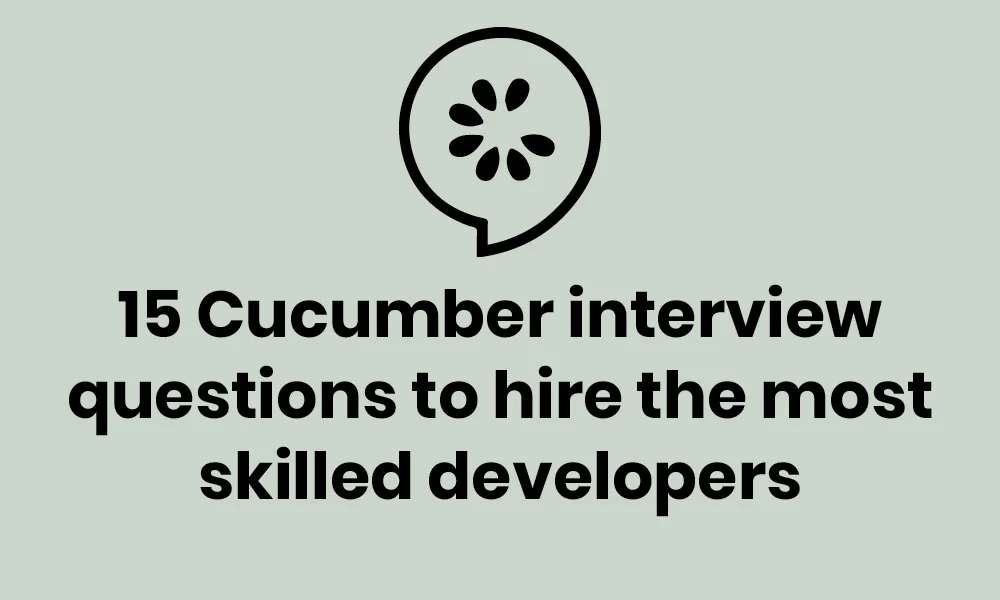Are you on the hunt for an outstanding software developer or tester with strong Cucumber skills? In this case, you need to assess applicants’ ability to understand and manipulate Cucumber.
The benefits of a strong testing process are numerous, making Cucumber an invaluable tool for any organization. A software that gives businesses a strong accountability framework and assurance in their methods is more than welcome in any firm.
If your company is using Cucumber, it’s essential that your next software developer or tester demonstrate their skills in Cucumber and in other related programming tools and languages. Our Ruby (Data Structures) test, for example, can help you filter out the best candidates before they even come for an interview.
Once you’ve invited the top candidates for interviews, you can then use the following Cucumber interview questions to really get a sense of which candidates stand out from the rest.
We’ve included sample answers to help you evaluate applicants easily, even if you’re not proficient in Cucumber yourself. In the first section, you’ll find a general overview of the software tool to give you enough context.
Let’s dive in.
Table of contents
- What is Cucumber?
- 15 Cucumber interview questions to hire the most skilled developers
- Tips for using Cucumber interview questions
- For what job roles can you use Cucumber interview questions?
- At which stage in the interview process should you use Cucumber interview questions?
- Use Cucumber interview questions to hire the best
What is Cucumber?
Cucumber is a software tool that allows users to run tests on various scenarios to ensure a specific piece of software functions as it should.
Cucumber enables behavior-driven development (BDD), a method of collaborative working that helps software testers, developers, and customer specialists work together to turn complicated software into a more consumer-friendly end product.
Cucumber is an important tool because it validates the functionality of software. It gives companies the assurance they need to be confident in their systems, while offering important insights to software developers and testers.
Originally written in the Ruby programming language, Cucumber now supports a wide variety of coding languages and systems, including JavaScript. This makes it easier to implement alongside other software frameworks and tools.
15 Cucumber interview questions to hire the most skilled developers
To hire the best employees, recruiters need the right tools. Below, you’ll find 15 Cucumber interview questions that you can use as a hiring manager to recruit top talent for your organization.
1. What is Cucumber?
This is the most basic question you can ask. It’s one that may feel a little patronizing for experienced developers, but may be worthwhile if you’re hiring for lower-level positions. This question is designed to test a candidate’s fundamental knowledge of Cucumber and to examine their ability to give concise yet detailed answers.
Ideal candidates will give answers that cover the fundamentals and go into the key features and benefits of Cucumber, without rambling or diverging from the question too much.
2. What are the advantages of Cucumber?
Experienced candidates will be well aware of the benefits of Cucumber.
Asking a broad question like this can help you get a better insight into how a candidate has used the software in the past. It can reveal whether an interviewee has the right knowledge to create success within the role.
An ideal answer would include both the general benefits of Cucumber and some personal anecdotes about how a candidate has made use of these advantages. For instance, they might mention how behavior-driven development has facilitated cooperation with other developers in the past.
3. What is the main purpose of behavior-driven development (BDD)?
Behavior-driven development is a process of simplifying complex programming language into text that’s much easier to understand.
In this way, employees from various departments can work together on projects, taking advantage of the plain-text language that BDD software uses. As such, its main purpose is to facilitate cooperation among different branches of a company.
This is a crucial question to ask a candidate during an interview. BDD is an essential element of Cucumber and one that can drive success within the company, so it’s important that a potential employee has a working knowledge of the concept.
If they understand the importance of BDD, your new recruit will be able to integrate into your company easily and begin working alongside other departments.
4. What programming language does Cucumber use?
Cucumber was originally written in Ruby, but it now supports a whole host of different programming languages. These include .NET, Java, and JavaScript.
Cucumber can also be integrated with other programming tools, such as Selenium, RSpec, and Capybara, making it a versatile software testing tool.
Software developers should know the programming language that Cucumber uses, as well as the fact that it supports many different computing language formats. This question is ideal for entry-level positions, but it might be worth using in interviews for more experienced roles, too.
5. What is the Gherkin syntax in relation to Cucumber?
This is a great way to assess a candidate’s level of Cucumber knowledge.
More experienced users will know of the Gherkin syntax system, which uses keywords to perform sequences and create software tests. Its core concept is that it allows developers to run tests without using complicated coding language.
Ideal answers will give detailed information about the Gherkin syntax and how it’s beneficial for Cucumber users. Although it’s a near-fundamental aspect of Cucumber, the Gherkin syntax requires a somewhat advanced knowledge of the software to coherently explain. As such, this question will filter out the top candidates from the rest.
6. What files are required to begin a Cucumber test?
There are two files that users will need to initiate a software test using Cucumber. These are known as feature files and step definition files. Both are required in order to properly use Cucumber, so it’s important that a candidate has good knowledge of them if Cucumber plays a large part in the job role.
Asking this question is a quick and easy way to gauge a candidate’s level of expertise in Cucumber. A sound knowledge of these fundamental file types is required to run successful software tests, so you’ll want to be sure that your candidates have it.
7. What is a feature file in Cucumber?
A feature file is one of two files that are required to start a testing process in Cucumber. It gives testers an accurate description of an Application Under Test (AUT) and pertains to a function that the test will perform. Each feature file must begin with the keyword “Feature” and may include several different functions within itself.
An ideal response from a candidate will cover the fundamentals of what a feature file is. There’s no need for a long answer from them, but they might weave in previous experience that they’ve had using feature files. As a hiring manager, look for experienced candidates who can give confident answers to technical questions like this one.
8. What is the maximum number of scenarios that a feature file can contain?
The maximum number can vary depending on the project and organization, but the general limit is 10 scenarios. Restricting the maximum number of scenarios for a specific feature file is a great practice when running tests on Cucumber.
Again, this question tests candidates’ knowledge levels and assesses their technical abilities. A more experienced Cucumber user will give more information than a rookie, so look for comprehensive and accurate answers.
9. When writing a Cucumber test scenario, what keywords are used?
There are four keywords used in Cucumber when writing test scenarios:
Given
When
And
Then
Each one constitutes a specific action taken within a test scenario. Given that these keywords are vital in testing various software, this question is particularly important to ask in an interview for a tester position.
The best candidates will demonstrate a profound knowledge of Cucumber and the Gherkin language system it uses by listing the keywords used in test scenarios and what their functions are.
A candidate may not cover every single keyword, but should still convey enough information to demonstrate their Cucumber abilities to an appropriate level according to the position they’re applying for.
10. What are the stages of the BDD process?
The behavior-driven development process has multiple stages to it, often involving employees from different departments.
The first stage, sometimes termed the discovery phase, involves collaboration to determine acceptance criteria for the test scenario. Next come the testing stage and the automation stage, where test scenarios are run and then automated to continue running without manual input.
This question is more complicated and requires a higher degree of technical knowledge. If you’re conducting interviews for an entry-level position, candidates may not give intricately detailed answers.
That said, those who provide a comprehensive amount of information will prove their expertise in Cucumber.
11. What is the difference between Cucumber and Selenium?
Both Cucumber and Selenium are excellent software testing tools with similar properties and capabilities. However, there are a number of differences between the two, primarily spanning their functions and features. For instance, Cucumber is centered around BDD, whereas Selenium is more technical and more widely used for web applications.
Although it’s not strictly focused on Cucumber, you might ask this question during an interview to gauge a candidate’s broader software knowledge. Testers and developers often work with multiple tools, so it’s important they have a wider understanding of the common business software tools available.
12. What is a regular expression in Cucumber?
A regular expression is a term that describes a pattern of a specific amount of text. Regular expressions can range in length from single characters at their most basic to multiple words using hundreds of characters.
This is a more advanced question designed to test the technical skills of candidates. Technical questions like this are exceedingly important when interviewing for tester or software-developer positions, as the job role requires a lot of technical expertise. Using these types of questions will help you probe around and find out just how much your candidates know.
13. What is a test harness in Cucumber?
A test harness enables users to separate the processes of inputting context into the test, connecting it with a browser, and tidying the cache of step definition files. The test harness is a useful tool for automation, as it gathers the stubs, drivers, and other features that an automated testing process needs.
During the interview stage, you may want to ask this question as a way of assessing a candidate’s depth of knowledge of Cucumber. The automation capabilities of the software can be massively beneficial for businesses, so ideal candidates will demonstrate that they know how to use Cucumber’s tools to automate tests.
14. What is the Options tag for and how would you use it?
The Options tag in Cucumber facilitates connections between the files used in the testing process.
In essence, it creates links between feature files and step-definition files, which builds up the testing procedure. Cucumber users will often use the Options tag in their work, combining this feature and glue parameters to create and run tests.
Use this question to further assess a candidate’s technical Cucumber knowledge. Skilled interviewees will demonstrate previous experience of using the Options tag in their work and will understand its benefits and functions in relation to business strategies.
15. What is a TestRunner class in Cucumber?
A TestRunner class is another method of providing links between the feature file and step definition file during a software test. More often than not, TestRunner classes are usually empty and undefined.
This question delves into more advanced aspects of Cucumber, so it’s perhaps more suited to senior positions. That said, the best candidates for any developer or tester position will likely understand what is meant by a TestRunner class within Cucumber, and will capably demonstrate their knowledge of this.
Tips for using Cucumber interview questions
There are various approaches you can apply to make full use of these Cucumber interview questions. For one, it’s worth adjusting the questions depending on the level of position you’re hiring for.
For instance, if you’re hiring for a senior role, focus on the advanced questions that delve into the technical aspects of the software. They likely have a lot of experience in this area, but you’ll want to know for sure that they can handle the technical responsibilities of the role.
For junior positions, candidates will have more room to learn on the job. It’s more important that interviewees demonstrate strong interpersonal skills and a willingness to learn, so you know that they’ll be a good fit for your company culture. As such, feel free to focus on the more situational questions.
For what job roles can you use Cucumber interview questions?
Cucumber specialists are usually software developers, software testers, or a bit of both. As such, it’s worth using these Cucumber interview questions to hire excellent developers and testers for your team.
However, many other IT professionals will use Cucumber in their everyday work lives. Some of these interview questions are therefore appropriate for almost any IT role, and can be used to gain as much insight into a candidate’s knowledge of Cucumber as needed for the role.
At which stage in the interview process should you use Cucumber interview questions?
To get the best use out of these questions, you should use them during the interview stage and at the bottom of your hiring funnel. Something companies frequently overlook, though, is that recruiters can ask candidates to take a pre-employment assessment before being invited to an interview.
This is a great way of identifying the very best candidates and ensuring that those who come for an interview have already proven their skills in a certain field. It’s particularly important when the positions you’re hiring for are highly technical, as is the case with software developers and testers.
Thus, these Cucumber interview questions are of better value when used after screening tests: They are a great way of reaffirming a candidate’s already proven knowledge and gaining a deeper understanding of their skills and experience.
Use Cucumber interview questions to hire the best
Software developers and testers are invaluable additions to any software company. Their work with Cucumber can help validate any software that you use or build. Because of this, it’s important that your employees who work with Cucumber have the appropriate level of knowledge to ensure every bit of software functions as it should.
To enable a strong recruitment process, skills-based hiring is the way forward, which is the reason we offer pre-employment tests that cover a whole variety of skills and abilities. With our tests, you can be sure you’re hiring the very best talent for your open positions.
But TestGorilla’s help doesn’t stop there. We’ve got a whole bunch of interesting articles that feature hiring tips, as well as sample interview questions and answers like the Cucumber ones above. In combination with skills tests, these will enable you to build a bulletproof hiring process.
Check out our TestGorilla product tour to see how you can boost your recruitment and hire top talent for your company.
Related posts
Hire the best candidates with TestGorilla
Create pre-employment assessments in minutes to screen candidates, save time, and hire the best talent.
Latest posts
The best advice in pre-employment testing, in your inbox.
No spam. Unsubscribe at any time.

Hire the best. No bias. No stress.
Our screening tests identify the best candidates and make your hiring decisions faster, easier, and bias-free.
Free resources
This checklist covers key features you should look for when choosing a skills testing platform
This resource will help you develop an onboarding checklist for new hires.
How to assess your candidates' attention to detail.
Learn how to get human resources certified through HRCI or SHRM.
Learn how you can improve the level of talent at your company.
Learn how CapitalT reduced hiring bias with online skills assessments.
Learn how to make the resume process more efficient and more effective.
Improve your hiring strategy with these 7 critical recruitment metrics.
Learn how Sukhi decreased time spent reviewing resumes by 83%!
Hire more efficiently with these hacks that 99% of recruiters aren't using.
Make a business case for diversity and inclusion initiatives with this data.



















